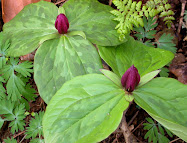This week I have been reading Louis J. Halle’s
Spring in Washington and when talking about the thrushes he said it was “remindful of lizards, with which they share a distant common ancestor”. Many times I have read this but could never really see it until now. When I looked at some of the birds that were at my feeder this snowy day I could see that stare and indeed they do look like lizards.
HERE are a few that came to my feeder today during the snow storm. I have included a little information about each of them that I found in
Bird Tracks & Signs by Mark Elbroch and National Geographic
Society’s Song and Garden Birds of North America.
Northern Flicker (
Colaptes auratus)
Toes 1 and 2 are much shorter than toes 3 and 4, which is true for all woodpeckers. The tracks look to me like a “K”. I read that they like to dig into ant hills and you can see their tracks around the dig site as well as beak marks. Notice in this photo you can see the yellow shafts of this eastern species. When I am in California during the winter I see the red-shafted flickers. The male has a black moustache.
You can see the yellow shaft of the feather in the photo above.
This is a female
Pileated Woodpecker (
Dryocopus pileatus)
I am fortunate to live in an area that has this wonderful large woodpecker. They are very cautious when visiting the feeder and look around a great bit so as to not be caught unaware. The smaller birds all flock around the get the dropped bits of the suet. It is especially helpful when the suet has been out for a long time in the cold and it hard to break into. Wingspan of 24-30 inches. The males have a red moustache.
This is a female.
Woodpecker have a zygodactyls foot pattern with two toes forward and two backward. It is the second most common foot pattern among birds. Toes 1 and 4 point backward, and toes 2 and 3 pint forward. You can see how this would help them balance on the side of a tree.
I’m sure you have noticed the elongated holes that they make into trees. Often mice use then more nests. The Pileated is after the carpenter ants that feed on the interior wood that provides structural support to the trees. We can’t see them but the Pileated can hear them.
Red-bellied Woodpecker (
Centurus carolinus)
Feeding on berries and corn it is one of the few members of the woodpecker family that eat more vegetable matter than insects. In Florida it eats the pulp of oranges. The male has an all red crown.
This is a female.

Here is a male. You can see the red goes from the back to the front without a break.
You can see the red bellie better in this photo.
Hairy Woodpecker (Dendrocopos villosus)
The Hairy is larger than the Downy but it is hard to tell if you don’t have them side by side. One way is to look for the outer tail feathers, is they are solid white it is a Hairy, the Downy has black spots in that location. I learned to tell the difference by the bill length because the Hairy has a much longer thicker bill. The Hairy woodpeckers drill into wood more often that the Downy and the holes are larger and deeper which makes sense because of the bill size. They also drill into harder wood.
This is a female Hairy.
Downy Woodpecker (
Dendrocopos pubescens)
This little woodpecker has a tiny sharp pointed bill and often drills into Goldenrod Galls that can be found this time of year.
This is a female Downy. Compare the size with the Hairy in the previous photo. Notice the bill size and the overall body size in relation to the feeder.
Goldenrod Gall drilled into by a Downy Woodpecker
The males have the red on the back of their heads. Here is a photo of a Downy and a Nuthatch both in typical poses.
White-breasted Nuthatch (
Sitta carolinensis)
These guys are hard to photograph because just as they get into focus they fly off with a bit of food in their mouths. Their habit is to choose one spot and take seeds or nuts there to be opened over and over again. Now if that spot was in view I would be all set to watch it feed but alas it is to the side of the house and I cannot see it. They like to jam the food into a crevice of a tree and open it there.
Dark -eyed Junco (
Junco hyemalis)
The tracks of the Junco are side by side because they hop around on the ground. Here is a photo of a Junco tracks in deep snow and you can see where it’s tail was dragging.
This is a male.
The female is lighter and has more brown color.
Carolina Chickadee (
Parus carolinensis)
This is the most common Chickadee in my area. North of me and at higher altitudes in West Virginia the Black-capped can be found but we only have the Carolina in my neighborhood. They often feed on the underside of twigs and leaves and find insects and caterpillars that other birds miss. They build their nests in old woodpecker holes, decayed stumps, bridge supports and small birdhouses to name a few. The nest is made up of grass and bark and lined with fur, feathers and thistledown. According to the National Geographic source they often they build one side of the nest higher than the other to make a flap to cover the eggs when away.
Tufted Titmouse (
Parus bicolor)
They like to build their nest of moss, hair and bark shreds in a tree hollow and sometimes in a bird box. In a story about Opossums that I recently read this brave little bird was pulling hair from the live Opossum for its nest. That would be like me jumping onto a Rhinos back to pull out a few hairs…I don’t think so. I’m not that brave.
Carolina Wren (
Thyyothorus ludovicianus)
This little guy loves to sing year round. Currently I am having trouble keeping them out of the basement. I know it is cold outside but each morning I see them in the garage. They are one of the hardest for me to photograph because they are in constant motion like a little chattering windup toy. But I would dearly miss them if they were not flitting about.
Eastern Bluebird (
Sialia sialis)
Thoreau said that this bird “carries the sky on its back.” I would have to agree. They like to nest in boxes and like my friend in the valley tends to. She draws them to a platform feeder at her window with mealworms.
This is the male and in the spring he will be even more brilliant.
The female is not as blue as the male but has subtle colors.
Hope you enjoyed seeing and learning about these birds as much as I did. By they end of the day I had six and half inches of snow and lot and lots of photos.
























































+DSCN5800+for+blog.jpg)
